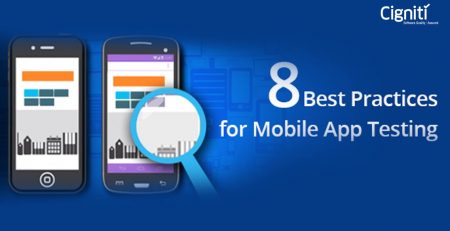Top 5 Factors of a Successful Mobile Application Testing Strategy
Gartner estimates that over 268 billion mobile downloads will generate an income of $77 billion in 2017. The estimated global mobile app revenue was $35 billion in 2014, and is predicted to touch $77 billion in 2017.
Mobile applications are indispensable, as every consumer and end-customer for a business needs access to your application/website over a portable device. It is the initial face of your company/business, which needs to make an impact. This makes mobile application testing strategy business critical, where the application is tested for accessibility, security, availability, and needed functionality.
[Tweet “Set your objectives for an effective #MobileAppTesting strategy. #softwaretesting #QA”]
Just building an application and launching it in the consumer world doesn’t make sense, unless you make it absolutely compelling for users. Play Store might offer hundreds of applications, but your business application might not be noticed unless you make your proposition and interface engaging enough. It needs constant updates and facelifts to drive users and achieve the expected business objectives. This has led to the popularity of fresh approaches in development and testing such as, DevOps, Agile, and Shift-left.
The core strength of these approaches is to make testing a part of the development process and ensure that quality is a shared responsibility.
We have put together the top 5 aspects that Software Development and Testing teams must consider while designing an effective testing framework and a comprehensive mobile application testing strategy.
[Tweet “Top 5 things to consider for an effective #MobileAppTesting strategy. #softwaretesting #QA”]
1. Establish the testing goals
Any testing and development activity needs to establish the ultimate business goals. This helps in defining the efforts, approach, and expected outcomes. For instance, if a gaming application has to be tested for compatibility and performance across devices, Test Automation is a recommended approach. With test automation, the application can be tested simultaneously across devices and operating systems. This not only cuts down the time taken, but also helps to reduce the efforts and achieve better test coverage.
The overall approach towards Mobile Application Testing predominantly depends on the end objectives. While faster time-to-market, cost-effectiveness, and enhanced test coverage are some underlying objectives, every application is unique; what sets it apart is the outcome that it expects from the users. Establishing the same can solve some major and minor issues.
2. Consider Test Automation with a goal
While Test Automation is an enabler for testers to bring down the costs and achieve better test coverage, it is an approach that must be reviewed and planned strategically. Only implementing a test automation tool or framework doesn’t make sense. It needs to be implemented by putting together objectives and understanding what you intend to achieve by using the tool – whether Compatibility, Security, Accessibility, Responsiveness, and anything else that can make the application more competent in the digital space.
Test Automation calls for more investment, not just for getting the tool, but also for training the resources and getting the tool operational. If the required objectives for automation are not defined, it might lead to waste of time and resources. Moreover, it is also recommended to get a dedicated team for establishing automated testing.
3. Prioritize Security of the application
Cyber-attacks and virus threats are causing worries for every business that is operational in the digital space. Mobile applications are equally vulnerable to cyber-attacks and can expose sensitive information about the users. Applications are susceptible to viruses that may lead to financial losses as well. Along with performance of the application, ensuring security aspects is equally critical for enterprises while testing mobile applications.
Security Testing approaches such as Vulnerability Scanning, Security Scanning, Penetration Testing, Risk Assessment, Ethical hacking, and Security Auditing are some critical steps for Mobile Application Testing.
4. Test Early to ensure quality
New approaches in software/application development recommend early testing, which helps ensure quality at each milestone and gets the application market-ready. This not only helps save costs, but also ensures that quality is a shared responsibility. Agile, DevOps, and Shift-left are some key testing approaches that help cut down the testing efforts and at the same time ensure better test coverage for the application.
Moreover, this helps to ensure frequent releases and assurance of performance at any point in the application’s lifecycle. This kind of readiness is absolutely important in the era of Digital Transformation. The mobile application market is highly competitive, and consistency in performance is a must. Hence, ensuring quality while the application is being developed is the need of the hour.
5. Emulators Vs. Actual Devices
There are various options for testing the performance of the application before it goes in the live environment. While emulators/simulators are options to consider while testing the application, it is recommended to use the actual devices for testing the performance and responsiveness of the applications. This helps get credible results on the application’s compatibility on devices and even across various networks. At the same time, it can be an effective way to test the application on devices that could be relevant for the application. For instance, a gaming application can be accessed and played only on particular screens. Testing applications on all the devices doesn’t make sense in this case.
An effective mobile testing strategy has to define the devices, operating systems, and network configurations. This helps testers and development teams to get the expected outcome from the testing efforts. Most importantly, it also helps save infrastructure costs and cuts down efforts rationally.
[Tweet “What makes a brilliant #MobileAppTesting strategy? #QA#mobiletesting”]
In Conclusion
Technovia research estimates that, the global Mobile Application Testing (MAT) services market is anticipated to grow rapidly and will post a CAGR of more than 18% during 2017-21. The rapid implementation of agile testing and test automation services will drive the growth prospects for the global MAT services for the next four years.
There are multiple MAT tools in the market that can help achieve diverse objectives. Investing in a tool is very much important, but it is equally important to list down the reasons for doing so. A strategy with clear testing objectives is very much important to rationalize the costs and the resources.
Cigniti’s Mobile Testing CoE provides access to a wide range of testing services, tools, and a mobile device lab. Connect with our experts and leverage our extensive experience to build a relevant strategy for your mobile application.





Leave a Reply